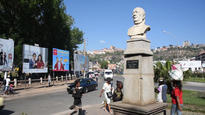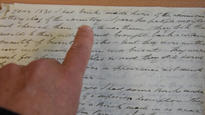INGAHY KAMA
In the film Ingahy Kama, inhabitants from Madagascar and its capital Antananarivo read aloud (fragments of) the correspondence of James Cameron and other missionaries. The fragments refer directly to the series of 34 photographic prints of letters that are on view at the exhibition (the work Letters of Cameron and his Fellow Missionaries between 1825 and 1875 (2018). The fragments that are read aloud here, have been transcribed by the artist with white print, which allows the viewer to seek a personal interpretation.
Michels’s Ingahy Kama, which translates roughly as Mister Cameron in the local language, links/contrasts the written world with spoken language. The work also illustrates the tension between the sometimes seemingly incontestable power of ‘historiography’ and the relevance of the weight of personal experience(s).
For indeed, the interpretation of history is never univocal—and neither is the history of Madagascar and (the figure and heritage of) James Cameron. Yet the letters and writings by him and other missionaries, which are today conserved in London—and which are therefore practically inaccessible to Madagascans— are often used for writing ‘local’ history. Furthermore, it were the missionaries which were the first to write down the local languages.
In this audiovisual work Madagascans read out fragments of the correspondence in a homely atmosphere— and through this act Michels ‘gives back’ these letters symbolically to them. The close-ups alternate with shots of the letters and with impressions of the towns where Cameron left his traces. Cameron himself is represented by a Scottish actor, who also interprets the parts of other Scottish and English missionaries that were his contemporaries. Cameron never enters the image and seems to speak to us from the past. The fragments Bie Michels has chosen, illustrate merely a tiny snippet of Cameron’s influence in the evolution of the country. We hear not just about improvements, such as the manufacture of bricks, but also about the missionary’s doubts. Cameron for example wanted to share his knowledge about melting iron, which could have resulted in a tremendous progress, but also in the production of weapons (canons). Of course, this confronted Cameron with a moral issue.
To conclude we also gain insight in the position of the missionaries and the troubled relationship between Christianity and the local traditions.
On the one hand, there are particularly dubious statements by and controversial opinions of the missionaries (about ‘teaching the right faith and civilization’), but on the other hand Ingahy Kama also tells about how locals who converted to Christianity were persecuted by their rulers.



- Formaat DIGITAL FILE(DIGITAL FILE)
- Kleursysteem PAL
- Kleur col.
- Jaar 2017-2018
- Duur 00:24:00
- Taalinfo
Ondertitels: English UK
Gesproken: English UK
-
Kunstenaars